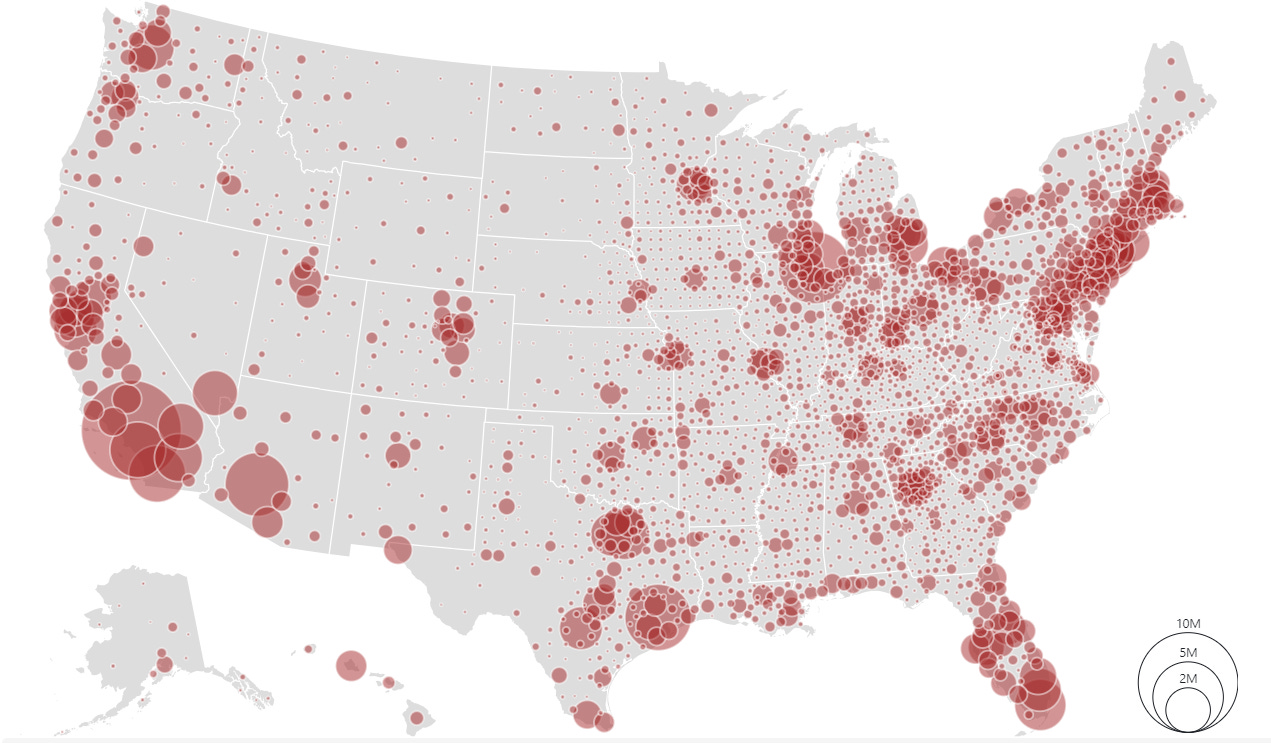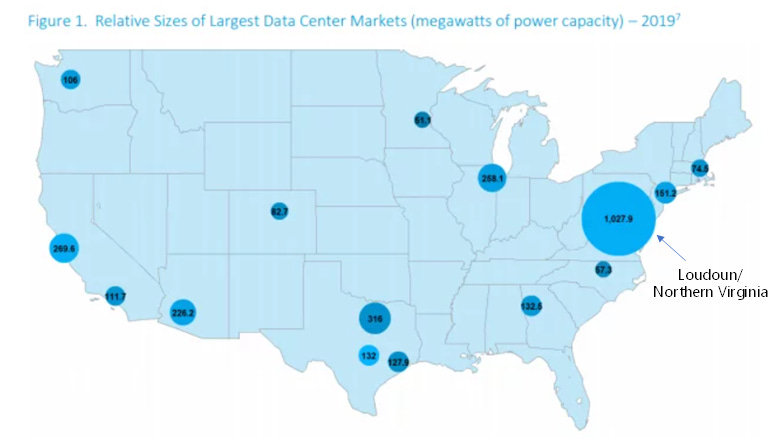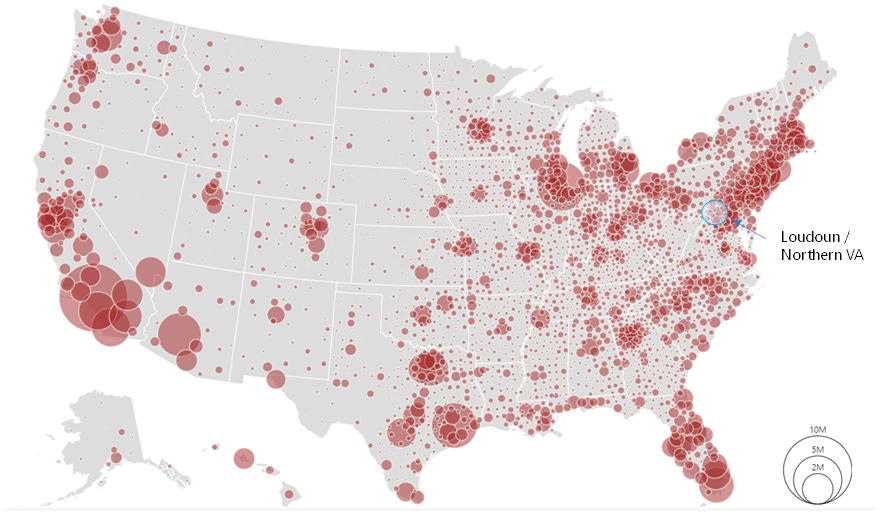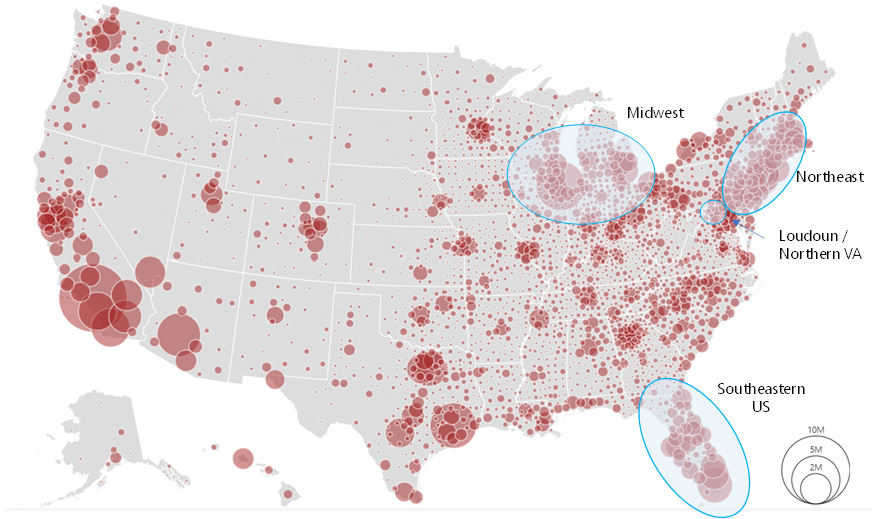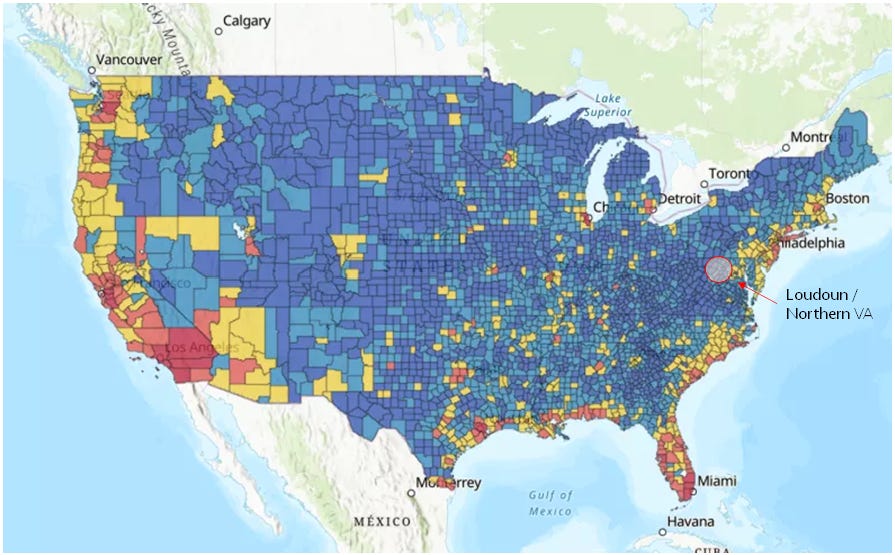Accelerating Advantages
I've never really thought that much about data centers. Like so many of the things we interface with in daily life, the digital world / internet was designed that way - an easy-to-use product requiring zero fundamental understanding of how it works.
All I really knew was that data centers are a key part of internet infrastructure - it's where data and algorithms are stored and where our computers obtain the data that comes to us when we load up our email or Netflix or ask Google a question.
So if you had to ask me how data centers would be distributed across the US, I'd have guessed a map that looks like the following:
Source: Observablehq.com
I.e., a map with data centers well distributed according to population density. But then I chanced upon a stat that blew my mind - that 70% of the US's data centers are located in just two regions in the US. Santa Clara in the Silicon Valley - which somewhat makes sense given it's in the heart of tech land - which is perhaps ~20% of the US data center market. It was the second one - Loudon County, Virginia - that surprised me. Northern Virginia, where Loudon is located, is 50% - yes, fifty percent - of the US data center footprint in the US. Pretty random, no?
The chart below is a bit dated but shows where data centers in the US are located as of 2019, as measured by power capacity which is a fair proxy for data center size:
Source: Northern Virginia Technology Council
While there is some correlation with population, data centers certainly don't look as well-distributed as the first chart. And certainly, when looking at Loudon, which sits on the fringes of the large population center that is the Northeast US, the concentration of data centers relative to population size sticks out like a sore thumb.
But how does an area with <1% of the US population end up housing 50% of its data centers?
Ultimately, it was the combination of Northern Virginia's inherent advantages and strategic policies that led to the heavy concentration and buildout of data centers in the region.
Advantage #1: Proximity to Innovation - The internet was funded out of research at DARPA - The Defense Advanced Research Projects Agency - which was based in Virginia. Substantial initial research and development on the internet occurred in the region, which led to Virginia being an early mover in internet infrastructure buildout. This created the perfect environment for Virginia to be on the forefront of internet innovation, as the region was the first to experience and then solve for complications associated with the build out of internet infrastructure. This is turn led to many of the initial innovators of the internet - including AOL - being located in Virginia, and as these companies expanded, brought many innovators and bright minds into the area, triggering further innovation, which then further built demand for internet infrastructure. Eventually, this led to Virginia being an early hub for everything internet-related, which has persisted in the data center buildout today. Valuable early momentum that created a competitive advantage.
Advantage #2: Geographic Advantage - Northern Virginia also had a couple of key geographic advantages that conferred a competitive advantage against other locales. First, it is strategically located as it is close to three major population hubs in the Eastern US - the Northeast, the Midwest (Chicago region), and the Southeast (Florida), which has not only made it an important fiber optic network hub but also the location from which to access these three major population hubs most efficiently.
Additionally, given the importance of uptime to internet providers and therefore data centers, natural disaster risk is a key concern for data center providers. Northern VA is a strategic location in this regard given it is largely immune from most natural disasters - there is close to zero earthquake risk (unlike California), limited tornado risk (unlike the middle part of the US), and low-ish hurricane risk relative to surrounding states given it's further inland than most population centers on the East Coast. The chart below shows natural disaster risk by region in the US:
Source: FEMA, via Newsweek
Taken together, this makes Northern Virginia an incredibly strategic location for data center locating, which further strengthens the gravitational pull of the region for new data centers.
Advantage #3: Land Abundance - Of course, the location of "Data Center Alley" on the fringes of the Northeast US population center is strategic in that it provides access to these population centers, but in being on the fringe allows a key component of data center cost - land - to be kept low. This cost/benefit balance is essential in further limiting the number of "optimal" regions for data center location.
Advantage #4: Power Cost - Data centers are known power guzzlers. Virginia has a cost of energy that is substantially lower than many other states. Per the EIA, Virginia's average retail cost of energy in 2022 was 10.75 cents / kWh. This is cheaper than many other states, like New York (18.33 cents), California (22.33 cents), Georgia (12 cents), and Pennsylvania (11.86 cents), and more than 10% less than the national average. This is driven by Virginia's access to cheap power gen sources, including low cost coal and natural gas plants given proximity to key coal and gas producing regions, as well as various low-cost nuclear power plants. Additionally, Virginia's utility - Dominion Energy - is known for being easy to work with for data center providers.
These 4 advantages are key endowments for the region that have made Virginia a special place for data center locations. However, one could argue there are other locations - perhaps in Central Pennsylvania, or North Carolina, that were also endowed with most of these advantages. Why weren't they able to compete as effectively?
The final piece of the puzzle - constructive government support - has probably been the key accelerator here that has allowed Virginia to set itself apart. Virginia has leaned into its competitive advantages and further accelerated them by making the state an easy place to do business for data centers. It was the first state to realize and then act on the large opportunity that the data center industry would become, enacting its first tax break in 2009. Since then, the state has written into legislature multiple tax incentives and grants that improve the economics for data center businesses, and continues to do so. As noted above, Dominion Energy, the state utility, has been easy to work with as well. Taken together, this enabled northern Virginia, to firmly establish itself as the preferred location for data centers.
This combination of factors - being aware and having a deep understanding of endowed competitive advantages, and then leaning heavily into these competitive advantages, is extremely powerful. I wrote a few weeks ago about how our own unique backgrounds - our memories, experiences, learnings - are a key source of our personal competitive advantage, as they are harder to replicable. However, the reality is that any entity trying to compete - whether a business, or a state, or an individual - is unlikely to be truly unique. By virtue of the diversity that exists in the world, there will almost always be some competitor that looks like us, even if we are fairly unique to begin with.
This is unavoidable - in the same way that Virginia can't avoid having other locations - Pennsylvania, North Carolina - from having similar endowed advantages. However, it is the ability to understand and then lean into these advantages that acts as a further opportunity to differentiate from the crowd, a further filter that separates the average from the brilliant. One that Virginia has expertly navigated in its pursuit of data center market dominance.
And in my experience, this ability is less common than one would think, as few spend the time and effort they should to think critically about their advantages and how they can further lean into and accelerate them. Exactly how we can do this - I'll leave to another week's post. But for now, an important reminder to myself as I think through how to design and build my career for the longer-term.
Dissipating Advantages
As a final point and corollary to the discussion above - just because an advantage is endowed doesn't mean that it will always exist. The world changes quickly and can quickly create constraints that enables weaker competitors to catch up.
In Virginia's case, the coming wave of data center demand from Generative AI might throw a wrench in their dominance. Given the massive growth expected in Generative AI, there will be a need for Gen AI-optimized data centers that some are forecasting might exceed existing data center by 2027. A key bottleneck for this data center demand, as noted above, is that of energy access.
While Virginia has been able to manage a somewhat more gradual increase in power demand from data centers over time as its utility has been able to make and then execute on longer-term plans for growth in electricity generation to met increase demand, the rapid increase in demand for Gen-AI data centers has created tough situation. There are increasing concerns that Virginia's grid will not be able to find enough power to meet all incremental Gen AI data center, leaving many involved in the build out looking elsewhere for power.
We are seeing increasing interest in building Gen AI data centers outside of Virginia as a result (e.g. Ohio, Arizona). This could prove to be a threat to Virginia's competitive advantage, and if not managed correctly, could mean Virginia's lead in the data center race gets eroded over time. Will be interesting to pay attention to as the Gen AI race heats up.
----
That's it for this week. Did my first triathlon, which was a fun and exhausting experience. Glad to be done with intense 6 days/week training and getting back to more sustainable (and fun?) workouts.



